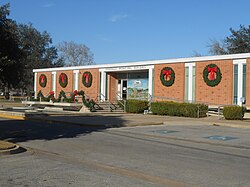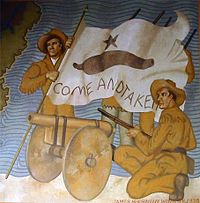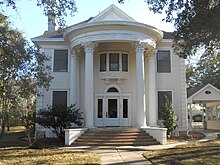Gonzales, Texas
Gonzales, Texas | |
|---|---|
 Gonzales' Municipal Building on St. Joseph St. was built in 1959 from plans by Emil Niggli and Barton Riley. | |
| Motto: "Where the fight for Texas liberty began"[1] | |
 Location of Gonzales, Texas | |
| Coordinates: 29°30′32″N 97°26′52″W / 29.50889°N 97.44778°W | |
| Country | United States |
| State | Texas |
| County | Gonzales |
| Government | |
| • Mayor | Connie Kacir |
| • City manager | Sean Lally |
| Area | |
| • Total | 6.08 sq mi (15.75 km2) |
| • Land | 6.08 sq mi (15.75 km2) |
| • Water | 0.00 sq mi (0.00 km2) |
| Elevation | 285 ft (87 m) |
| Population (2010) | |
| • Total | 7,237 |
| • Estimate (2019)[3] | 7,533 |
| • Density | 1,238.98/sq mi (478.34/km2) |
| Time zone | UTC-6 (Central (CST)) |
| • Summer (DST) | UTC-5 (CDT) |
| ZIP code | 78629 |
| Area code | 830 |
| FIPS code | 48-30116[4] |
| GNIS feature ID | 1336672[5] |
| Website | www |
Gonzales is a city in Gonzales County, Texas, United States. The population was 7,237 at the 2010 census.[6] It is the county seat.[7][8]
History

Gonzales is one of the earliest Anglo-American settlements in Texas, the first west of the Colorado River. It was established by Empresario Green DeWitt as the capital of his colony in August 1825. DeWitt named the community for Rafael Gonzáles, governor of Coahuila y Tejas.[9] Informally, the community was known as the DeWitt Colony.
The original settlement (located where Highway 90-A crosses Kerr Creek) was abandoned in 1826 after two Indian attacks. It was rebuilt nearby in 1827. The town remains today as it was originally surveyed.
Gonzales is referred to as the "Lexington of Texas" because it was the site of the first skirmish of the Texas Revolution. In 1831, the Mexican government had granted Green DeWitt's request for a small cannon for protection against Indian attacks. At the outbreak of disputes between the Anglo settlers and the Mexican authorities in 1835, a contingent of more than 100 Mexican soldiers was sent from San Antonio to retrieve the cannon.
When the soldiers arrived, only 18 men were in Gonzales, but they refused to return the cannon, and men from the surrounding area soon joined them. Texians under the command of John Henry Moore confronted them. Sarah DeWitt and her daughter sewed a flag bearing the likeness of the cannon and the words "Come and Take It", which was flown when the first shots of Texian independence were fired on October 2, 1835. The Texians successfully resisted the Mexican troops in what became known as the Battle of Gonzales.[10][11]
Gonzales later contributed 32 men from the Gonzales Ranging Company to the defense of the Alamo.[12] It was the only city to send aid to the Alamo, and all 32 men lost their lives defending the site. Susanna Dickinson, widow of one of the Alamo defenders, and Joe, the slave of William B. Travis, fled to Gonzales with news of the Alamo massacre. General Sam Houston was there organizing the Texas forces. He anticipated the town would be the next target of General Antonio López de Santa Anna's Mexican army. Gathering the Texians at Peach Creek east of town, under the Sam Houston Oak, Houston ordered Gonzales burned, to deny it to the enemy. He began a retreat toward the U.S. border. The widows and orphans of Gonzales and their neighbors were forced to flee, thus precipitating the Runaway Scrape.
The town was derelict immediately after the Texas Revolution, but was eventually rebuilt on the original site in the early 1840s. By 1850, the town had a population of 300. The population rose to 1,703 by time of the 1860 census, 2,900 by the mid-1880s, and 4,297 in 1900. Part of the growth of the late 19th century can be attributed to the arrival of various immigrants, among them Jews, many of whom became peddlers and merchants.[13]
Geography
Gonzales is located in central Gonzales County at 29°30′32″N 97°26′52″W / 29.50889°N 97.44778°W (29.508801, −97.447709),[14] on the northeast side of the Guadalupe River, just east of the mouth of the San Marcos River. U.S. Route 183 passes through the west side of the city, leading south 32 miles (51 km) to Cuero and northwest 18 miles (29 km) to Luling. U.S. Route 90 Alternate passes through the northern side of the city, leading east 18 miles (29 km) to Shiner and west 33 miles (53 km) to Seguin. San Antonio is 69 miles (111 km) to the west, and Houston is 136 miles (219 km) to the east.
According to the United States Census Bureau, Gonzales has a total area of 6.1 square miles (15.7 km2), all of it land.[6]
Demographics
| Census | Pop. | Note | %± |
|---|---|---|---|
| 1850 | 307 | — | |
| 1860 | 1,103 | 259.3% | |
| 1870 | 1,255 | 13.8% | |
| 1880 | 1,581 | 26.0% | |
| 1890 | 1,641 | 3.8% | |
| 1900 | 4,297 | 161.9% | |
| 1910 | 3,139 | −26.9% | |
| 1920 | 3,128 | −0.4% | |
| 1930 | 3,859 | 23.4% | |
| 1940 | 4,722 | 22.4% | |
| 1950 | 5,659 | 19.8% | |
| 1960 | 5,829 | 3.0% | |
| 1970 | 5,854 | 0.4% | |
| 1980 | 7,152 | 22.2% | |
| 1990 | 6,527 | −8.7% | |
| 2000 | 7,202 | 10.3% | |
| 2010 | 7,237 | 0.5% | |
| 2019 (est.) | 7,533 | [3] | 4.1% |
| U.S. Decennial Census[15] | |||

As of the census[4] of 2010, there were 7,237 people and 2,243 households in the city. The population density was 1,412.8 inhabitants per square mile (545.5/km2). There were 2,869 housing units at an average density of 562.8 per square mile (217.3/km2). The racial makeup of the city was 71.5% White, 7.40% African American, 1.00% Native American, 0.40% Asian, 0.00% Pacific Islander, 21.15% from other races, and 2.20% from two or more races. Hispanic or Latino of any race were 47.2% of the population.
There were 2,571 households, out of which 36.0% had children under the age of 18 living with them, 47.0% were married couples living together, 15.7% had a female householder with no husband present, and 31.4% were non-families. 28.2% of all households were made up of individuals, and 16.5% had someone living alone who was 65 years of age or older. The average household size was 2.73 and the average family size was 3.35.
In the city, the population was spread out, with 29.7% under the age of 18, 9.6% from 18 to 24, 24.9% from 25 to 44, 18.7% from 45 to 64, and 17.0% who were 65 years of age or older. The median age was 34 years. For every 100 females, there were 91.4 males. For every 100 females age 18 and over, there were 86.5 males.
The median income for a household in the city was $27,226, and the median income for a family was $34,663. Males had a median income of $22,804 versus $18,217 for females. The per capita income for the city was $12,866. About 14.8% of families and 20.9% of the population were below the poverty line, including 25.5% of those under age 18 and 23.0% of those age 65 or over.
Education

During the 19th century, the town was a center for higher education in Texas. Construction began in 1851 and the college opened in 1853, with 50 students. An 1855 addition for the men's program was torn down during the Civil War; the materials were used to build Fort Waul, just to the north of the town. By 1857, the school granted bachelor of arts degrees to females, making it one of the earliest colleges in Texas to do so. The college was purchased in 1891, and its building converted into a private residence by W.M. Atkinson.
The city of Gonzales is served by the Gonzales Independent School District and is home to the Gonzales High School Apaches.[16] According to the University Interscholastic League of Texas, the Gonzales Apaches football team is in the 4A-1 Region IV District 15; Division: 4A-1.[17]
The city of Gonzales also is home to the Gonzales Center, a branch of the Victoria College which is located in Victoria, Texas.[18]
Media
Newspaper – The Gonzales Inquirer was established in 1853. It is one of the six oldest county newspapers still operating in Texas.[19][20]
Radio – Radio station KCTI has served the city and county since 1947.
Historic monuments and buildings
The site of the Battle of Gonzales, in the village of Cost, off Highway 97, is marked by a handsome stone and bronze monument commissioned by the State of Texas in 1910. The Come and Take It monument is the work of the Italian-born San Antonio artist Pompeo Coppini, Texas' leading sculptor in his day.
The Gonzales County Courthouse (1896), on the National Register of Historic Places, is by the master of Texas courthouses, James Riely Gordon. Winning a country-wide competition for the Bexar County Courthouse in San Antonio launched Gordon's career, as the first of 72 courthouses, 18 of them in Texas (with 12 remaining in this state). J. Riely Gordon was also a master of the Romanesque Revival style, hugely popular in the 1890s, and seen here with good effect.
Historic houses
Gonzales has an exceptionally high concentration of historic houses and buildings.
In 2012, This Old House named Gonzales as one of the Best Old House Neighborhoods,[21] noting its well-preserved downtown, its large stock of affordable and fixer-upper fine houses in Queen Anne, Tudor Revival, Italianate, and Greek Revival styles, as well as the town's low cost of living and convenience to the big cities of Austin, San Antonio, and Houston.
The oldest dwellings in Gonzales date to the mid-19th century, but most of the architecturally notable houses were constructed beginning in the late Victorian period, from about 1880 to about 1915. Queen Anne style houses are the most common, with Colonial Revival and Classical Revival houses as well. J. Riely Gordon and Atlee B. Ayers were among the renowned architects active here. Many of the most notable homes, built for the important families of Gonzales, were erected along St. Louis St. and St. Lawrence St. Those two roads edge, to the south and north, a long stretch of public land one block wide running from the historic downtown commercial center and courthouse all the way to Kerr Creek to the east.
 |
 |
 |
 |
 |
 |
 |
 |
 |
Notable people
- Phil Coe (1839–1871), well-known saloon owner and Old West gambler, killed in the last known gunfight of "Wild Bill" Hickok.
- John Joel Glanton (1819–1850) early settler of Mexican Texas, and later a Texas Ranger. After the Mexican-American War, he became a terrorist and sadistic murderer and led the notorious Glanton Gang of scalp hunters in the American Southwest.
- Crispin Sanchez (1925–2008), a pioneer in Mexican-American education and sports. He excelled in baseball but chose college and earned his Ph.D. in education. He was an administrator at Laredo Community College for 23 years, and had an athletic field named in his honor.
- Jerry Hall (1956–), American supermodel, actress, and Mick Jagger's long-time companion and former common-law wife.[22]
- Myra Hemmings (August 30, 1895 – December 8, 1968) was a founder and first president of Delta Sigma Theta sorority, Inc., in 1913 on the campus of Howard University, Washington D.C.
- George W. Littlefield (1842–1920), Confederate army officer, Texas cattleman, banker, and regent of the University of Texas at Austin, lived in Gonzales during the 1870s.
- William Stubbs (interior designer), award-winning American interior designer, author, and television show host, born in Gonzales.
- Tom Sestak (1936–1987) Defensive Tackle Buffalo Bills 1962–1968 Member of the All-Time AFL Team.
Gallery of Gonzales
-
The 1902 Baptist Church in Gothic Revival style overlooks one of the central squares.
-
The Gonzales Museum was part of Texas' 1936 centennial celebration. Like the San Jacinto Monument, it is built of Texas shell stone. Stained by 76 years of air pollution, it was cleaned in early 2014.[23]
-
The Houston House at 621 St. George St. is a National Register residence.
-
The old Post Office was built in 1909, and is used as office space today.
-
The Fire Department is located in the center of town.
-
The Lynn is a mid-20th century downtown movie theater by architect Jack Corgan.[24]
-
Following the standard plan of cities in New Spain, the town is organized around a large central square of four parts: Courthouse Square, Confederate Square, Texas Heroes Square, and Church Square.
-
One of the largest downtown commercial buildings, the 1895 Randle-Rather Building sits at St. Paul and St. George Streets.
-
In one of the oldest sections of downtown, some of these stores on St. Lawrence St. date to the 1850s.
-
The historic commercial center is a National Register district, including this part on St. George St.
-
Built in 1901, Walnut Ridge (121 St. Joseph St.) was designed by J. Riely Gordon for James F. Miller.
-
The Gonzales Inquirer, one of the oldest newspapers in Texas, published since 1853, is headquartered on St. Paul St.
-
Following a major restoration, the Crystal Theatre on St. Lawrence St. is again used for live performances.
-
The 1874 Solomon Joseph House reflects a traditional house form in Queen Anne style so popular in the Victorian era.
-
The Edward Sweeney House (1926) at 1109 St. Lawrence St. displays English Tudor Revival style.
-
The T.H. Spooner House (1875) at 207 St. Francis St. is a National Register property.
Climate
The climate in this area is characterized by hot, humid summers and generally mild to cool winters. According to the Köppen Climate Classification system, Gonzales has a humid subtropical climate, abbreviated "Cfa" on climate maps.[25]
References
- ^ "City of Gonzales Texas". City of Gonzales Texas. Retrieved October 19, 2012.
- ^ "2019 U.S. Gazetteer Files". United States Census Bureau. Retrieved August 7, 2020.
- ^ a b "Population and Housing Unit Estimates". United States Census Bureau. May 24, 2020. Retrieved May 27, 2020.
- ^ a b "U.S. Census website". United States Census Bureau. Retrieved 2008-01-31.
- ^ "US Board on Geographic Names". United States Geological Survey. 2007-10-25. Retrieved 2008-01-31.
- ^ a b "Geographic Identifiers: 2010 Demographic Profile Data (G001): Gonzales city, Texas". American Factfinder. U.S. Census Bureau. Retrieved March 14, 2017.[dead link]
- ^ Hardin, Stephen L. (May 6, 2016) [June 15, 2010]. "Gonzales, TX". Handbook of Texas (online ed.). Texas State Historical Association.
- ^ "Profile for Gonzales, Texas, TX". ePodunk. Retrieved October 19, 2012.
- ^ "Come and Take It". Gonzales Texas Chamber of Commerce. Archived from the original on October 12, 2012. Retrieved October 19, 2012.
- ^ Davis (2006), p. 142.
- ^ Sonny Long (April 20, 2006). "Gonzales named top historical community in Texas". The Victoria Advocate. p. 2A. Retrieved December 29, 2012.
- ^ Edmondson (2000), p. 340.
- ^ Gonzales, Texas; "Encyclopedia of Southern Jewish Communities" online; accessed May 2018
- ^ "US Gazetteer files: 2010, 2000, and 1990". United States Census Bureau. 2011-02-12. Retrieved 2011-04-23.
- ^ "Census of Population and Housing". Census.gov. Retrieved June 4, 2015.
- ^ "Gonzales Independent School District". Gonzales Independent School District. Archived from the original on June 26, 2012. Retrieved October 19, 2012.
- ^ "University Interscholastic League Football District Alignment" (PDF). University Interscholastic League. Archived from the original on June 30, 2014. Retrieved February 19, 2014.
- ^ "Victoria College". Victoria College. Archived from the original on December 2, 2010. Retrieved February 13, 2015.
- ^ "Gonzales Inquirer". Gonzales Inquirer. Retrieved October 19, 2012.
- ^ Baumgartner, Dorcas Huff; Vollentine, Genevieve B. (February 2, 2016) [June 15, 2010]. "Gonzales County". Handbook of Texas (online ed.). Texas State Historical Association.
- ^ "Best Old House Neighborhoods 2012: The South". 9 February 2012.
- ^ "Jerry Hall". IMDb. Retrieved October 19, 2012.
- ^ Valerie Reddell (January 24, 2014). "Fresh face visible on Gonzales' Memorial Museum". Gonzales Inquirer.
- ^ "Archived copy". Archived from the original on 2014-07-21. Retrieved 2013-10-09.
{{cite web}}: CS1 maint: archived copy as title (link) - ^ "Gonzales, Texas Köppen Climate Classification (Weatherbase)". Weatherbase.
Further reading
- Davis, William C. (2004), Lone Star Rising: The Revolutionary Birth of the Texas Republic, Free Press, ISBN 0-684-86510-6
- Edmondson, J.R. (2000), The Alamo Story-From History to Current Conflicts, Plano, TX: Republic of Texas Press, ISBN 1-55622-678-0
- Frenzel, Paul (1999), Historic Homes of Gonzales, Gonzales, TX: Reese's Printing
External links
- City of Gonzales official website
- Gonzales Chamber of Commerce
- TourGonzales.com
- Account of the 1826 Indian attack from Indian Wars and Pioneers of Texas by John Henry Brown published 1880(?), hosted by The Portal to Texas History
- Gonzales Inquirer
- ePodunk: Profile for Gonzales, Texas
- City-Data.com


![The Gonzales Museum was part of Texas' 1936 centennial celebration. Like the San Jacinto Monument, it is built of Texas shell stone. Stained by 76 years of air pollution, it was cleaned in early 2014.[23]](http://upload.wikimedia.org/wikipedia/commons/thumb/1/15/Gonzales_Museum_-_Dec_2012.JPG/120px-Gonzales_Museum_-_Dec_2012.JPG)



![The Lynn is a mid-20th century downtown movie theater by architect Jack Corgan.[24]](http://upload.wikimedia.org/wikipedia/commons/thumb/8/89/Lynn_Theatre_-_Dec_2012.JPG/90px-Lynn_Theatre_-_Dec_2012.JPG)









